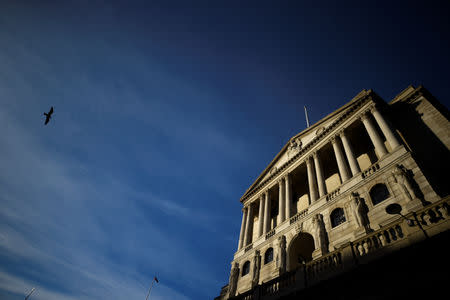UK inflation holds steady in October, bucking expectations for a rise
By Andy Bruce and Costas Pitas
LONDON (Reuters) - British inflation unexpectedly held steady in October, according to data on Wednesday that raises the prospect that the rate could return to target faster than the Bank of England expects.
Consumer prices rose at an annual pace of 2.4 percent in October, the joint-lowest inflation rate since March 2017, the Office for National Statistics (ONS) said. A Reuters poll of economists had pointed to a reading of 2.5 percent.
Food and clothing prices pushed down on inflation last month, offsetting a rise in utility bills and petrol prices, the ONS said. Sterling and British government bonds were little moved by the data.
Slowing inflation would boost the spending power of British consumers, whose wages, excluding bonuses, rose at the fastest pace since 2008 in nominal terms during the three months to September.
That backed up the Bank of England's view that a long period of weak pay increases is ending, and that it will need to raise interest rates in response to keep inflation at its 2 percent target in the coming years.
Still, analysts said Wednesday's figures added to signs that inflation may turn out weaker than the central bank expects.
"The consumer price figures support our view that, provided a Brexit deal is struck, inflation will probably be back at the 2 percent target next year," Ruth Gregory, economist at consultancy Capital Economics, said.
The BoE expects inflation to drift down but that the rate will remain just above 2 percent in two years' time as it gradually raises borrowing costs.
The bank's forecasts are based on the assumption of a smooth transition after Britain leaves the European Union in March 2019, something that may hinge on deliberations about a draft divorce deal with Brussels among Prime Minister Theresa May's cabinet on Wednesday.
Consumer price inflation hit a five-year high of 3.1 percent in November 2017, when the inflationary effect of the pound's tumble after the Brexit vote in June 2016 reached its peak.
Core inflation -- a gauge of underlying price growth that strips out energy, food, alcohol and tobacco prices -- also held steady at 1.9 percent in October.
The ONS figures suggested there may still be some short-term pressure in the pipeline for consumer prices.
Among manufacturers, the cost of raw materials -- many of them imported -- was 10.0 percent higher than in October 2017. Economists polled by Reuters had expected a 9.6 percent rise.
Manufacturers increased the prices they charged by 3.3 percent year-on-year compared with 3.1 percent in September, marking a four-month high and outstripping all forecasts in the Reuters poll.
(editing by David Stamp)

 Yahoo News
Yahoo News 

